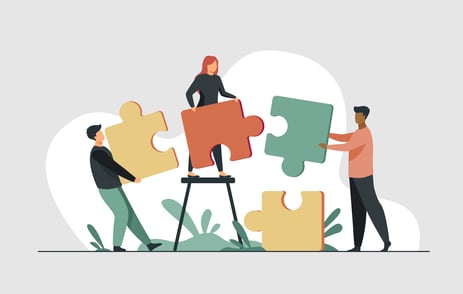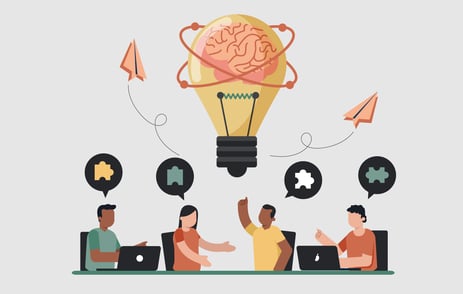Lisa heaved a big sigh. “Another reception—meh,” she thought. It wasn’t that she felt awkward or shy at receptions. Lisa was a classic extrovert. Meeting people wasn’t a problem for her at these events. The problem was meeting the right people. In a room full of a few hundred people, finding someone to have a meaningful conversation with was like finding a needle in a haystack.
Lisa led marketing at an architectural firm, and it felt like not many other people did what she did. Even though she had yet to meet others in her niche, she knew she wasn’t the only one struggling at these events. Being one of the most extroverted people in her industry, and to productively pass the time, Lisa appointed herself to the role of “introducer.” She would chit-chat with people until she found a match, then introduce people so they could have meaningful conversations. It was gratifying to know that she was able to help her more technically orientated colleagues start relationships. But what about her own meaningful networking?
Today's Networking Model
Despite the name, networking events often don’t produce much in the way of real connections, especially for the folks who most need to grow their network. In fact, networking events are synonymous with anxiety for many professionals, according to research by member engagement strategist Amanda Lea Kaiser. The study included 477 members from all types and sizes of associations.
Introverts assiduously avoid receptions and any activity billed as “networking” (a walk around town or reading a good book in their hotel room is far preferable). Ambiverts will attend a reception if they are traveling with fellow staff or friends but prefer to skip the big, loud event or leave early to have dinner with a smaller group. Extroverts like Lisa are the rare breed for which networking causes no anxiety, but they say it is not often they actually meet the person they need to meet.
Traditional networking events can be downright terrifying for solo travelers. These events are less frightening for people traveling with co-workers, but they tend to stay within the safety of their pack.
So, who are receptions for? People who are already deeply involved in their profession or industry who have an extensive and healthy network. These well-networked professionals love receptions because these events bring together their far-flung colleagues so they can reconnect with them.
Receptions are for long-time members, likely those who have served on your board. But receptions tend not to serve first-timers, introverts, ambiverts, infrequent attendees, and, of course, members who never attend. Counterintuitively, the reception model doesn’t serve most associations’ members.
How Are Association Members Networking?
So, how are most members networking? A few might initiate a conversation before a session or in the registration lines. Some people reach out to fellow members they’ve seen write or speak. Sometimes, people correspond over a mutually interesting topic in an association’s online community. A bit of networking is happening, but these connections require initiative and energy, and many professionals are too busy to make the overture.
Very little networking is actually happening. Amanda’s research further revealed that many members feel isolated and lonely. They think they are the only ones like them and suspect their experiences are unique. They lack support, ideas, camaraderie, validation, mentorship, motivation, and acceptance from others who do what they do and share their job experiences. People without robust networks can experience limited career opportunities and a slower career progression.
The value proposition for many associations is education and networking. While most associations excel at the education piece, there is a big opportunity for associations to create a significant quantity and better-quality networking opportunities.
How to Use AI to Elevate Networking Opportunities
This begs us to ask: What kind of networking experience would members find most valuable? First, they want to connect with people who have similar goals, work on the same projects, manage in like environments, and encounter the same problems. Meeting people like them makes networking meaningful. Second, they want networking to be comfortable. Volleying obligatory small-talk back and forth in an effort to find a point of mutual connection can be uncomfortable. Knowing what you have in common can help people speed through the awkward bit so they can get on with creating a relationship.
Many associations intuitively realize there is a sizeable networking opportunity to fill, but the processes for making those connections have been quite cumbersome. Phone calls, mentor programs, buddy systems, and member matching require a ton of manual labor and churn through staff hours. However, there is hope for the future.
Artificial Intelligence (AI) has the capability to make quality member matches without burning through staff resources. In addition, AI can improve the quality of these matches dramatically by considering a much wider array of factors than a human would have time to do for each individual. Let’s think for a moment about the types of information an association often has about its members:
- CRM data: Sure, our AMS isn’t often our favorite tool to use, but it has a lot of member information, including basic demographics and firmographics, as well as insights about the things they’ve done with us in the past
- Insights from engagement: Many platforms like HubSpot, rasa.io, and other engagement tools offer detailed analytics on a per-user basis about pages viewed, links clicked, and so on. From these insights you can determine with a fairly high degree of accuracy the interests of an individual (and their firm).
- Conference sessions: If you’re tracking individual level attendance at a session for CEU/CME/CLE type credit, you can also use this data to capture more insights on a real-time basis about the things attendees might be interested in based on where they spend time.
- Expo hall: Similar to sessions, knowing which booths attendees may have spent time there could be relevant for considering matching.
It is often said that “data is fuel for AI,” and this simply means that AI algorithms, as powerful as they are, can’t do a whole lot for you if you don’t have quality data available to feed them. In the case of using AI to improve matching, having some level of data is critical.
There are currently a wide array of AI tools and models that could help with matching attendees. The above examples of data that many associations have readily available are just that—examples. In many cases, the data that would be most relevant could be different. For example, in an environment where scholarly publishing is a major portion of what an association does, knowing what people have written, commented on, or simply read, can be valuable in creating matches.
At the moment, we are not aware of “out of the box” solutions that do exactly what an association wants for this type of matching; however, solutions will likely emerge to solve this specific problem. In the meantime, an association with even limited IT resources could build a matching process like this using some basic AI tools, such as smart features in its member relationship management system.
Grow Your AI Expertise Today
Have you considered using AI to further networking initiatives within your organization? Is this something you’ve already implemented? We’re looking to open conversation around this. Let us know how you’re leveraging AI to connect your members in the Sidecar Community.
Plus, don’t forget to sign up for our on-demand AI Learning Hub for Associations, which offers continuously updated content and a community of peers to keep your AI knowledge fresh, relevant, and applicable. Some key topics explored include:
- An introduction to AI and how to master AI prompting models
- Strategizing with AI to drive your association’s objectives forward
- Understanding how AI is revolutionizing sales and marketing
Sign up by clicking the button below.
%20(2).png?width=315&height=86&name=Untitled%20(600%20x%20400%20px)%20(2).png)

December 20, 2023


